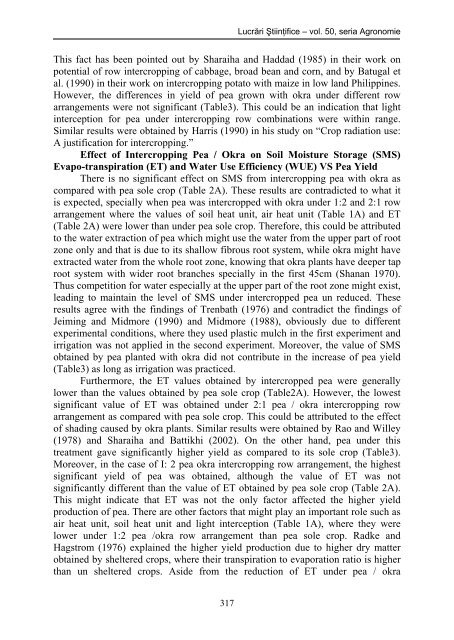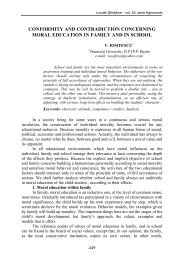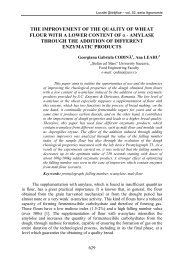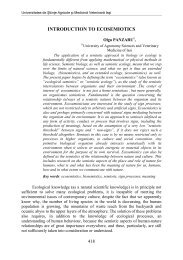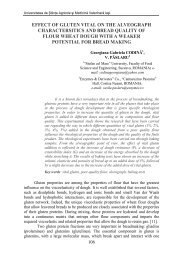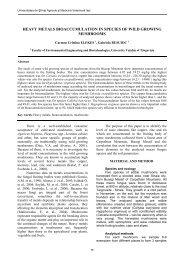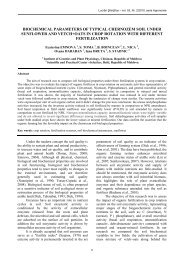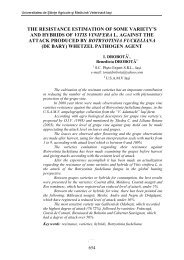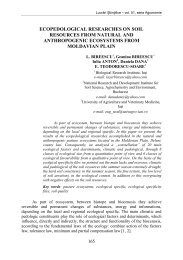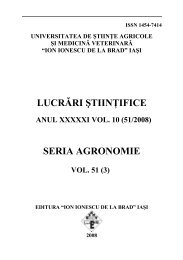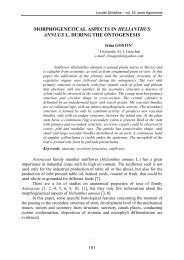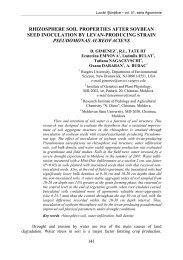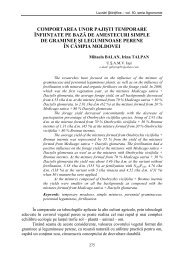environmental impact on yield of pea and okra grown under ...
environmental impact on yield of pea and okra grown under ...
environmental impact on yield of pea and okra grown under ...
You also want an ePaper? Increase the reach of your titles
YUMPU automatically turns print PDFs into web optimized ePapers that Google loves.
Lucrări Ştiinţifice – vol. 50, seria Agr<strong>on</strong>omie<br />
This fact has been pointed out by Sharaiha <strong>and</strong> Haddad (1985) in their work <strong>on</strong><br />
potential <strong>of</strong> row intercropping <strong>of</strong> cabbage, broad bean <strong>and</strong> corn, <strong>and</strong> by Batugal et<br />
al. (1990) in their work <strong>on</strong> intercropping potato with maize in low l<strong>and</strong> Philippines.<br />
However, the differences in <strong>yield</strong> <strong>of</strong> <strong>pea</strong> <strong>grown</strong> with <strong>okra</strong> <strong>under</strong> different row<br />
arrangements were not significant (Table3). This could be an indicati<strong>on</strong> that light<br />
intercepti<strong>on</strong> for <strong>pea</strong> <strong>under</strong> intercropping row combinati<strong>on</strong>s were within range.<br />
Similar results were obtained by Harris (1990) in his study <strong>on</strong> “Crop radiati<strong>on</strong> use:<br />
A justificati<strong>on</strong> for intercropping.”<br />
Effect <strong>of</strong> Intercropping Pea / Okra <strong>on</strong> Soil Moisture Storage (SMS)<br />
Evapo-transpirati<strong>on</strong> (ET) <strong>and</strong> Water Use Efficiency (WUE) VS Pea Yield<br />
There is no significant effect <strong>on</strong> SMS from intercropping <strong>pea</strong> with <strong>okra</strong> as<br />
compared with <strong>pea</strong> sole crop (Table 2A). These results are c<strong>on</strong>tradicted to what it<br />
is expected, specially when <strong>pea</strong> was intercropped with <strong>okra</strong> <strong>under</strong> 1:2 <strong>and</strong> 2:1 row<br />
arrangement where the values <strong>of</strong> soil heat unit, air heat unit (Table 1A) <strong>and</strong> ET<br />
(Table 2A) were lower than <strong>under</strong> <strong>pea</strong> sole crop. Therefore, this could be attributed<br />
to the water extracti<strong>on</strong> <strong>of</strong> <strong>pea</strong> which might use the water from the upper part <strong>of</strong> root<br />
z<strong>on</strong>e <strong>on</strong>ly <strong>and</strong> that is due to its shallow fibrous root system, while <strong>okra</strong> might have<br />
extracted water from the whole root z<strong>on</strong>e, knowing that <strong>okra</strong> plants have deeper tap<br />
root system with wider root branches specially in the first 45cm (Shanan 1970).<br />
Thus competiti<strong>on</strong> for water especially at the upper part <strong>of</strong> the root z<strong>on</strong>e might exist,<br />
leading to maintain the level <strong>of</strong> SMS <strong>under</strong> intercropped <strong>pea</strong> un reduced. These<br />
results agree with the findings <strong>of</strong> Trenbath (1976) <strong>and</strong> c<strong>on</strong>tradict the findings <strong>of</strong><br />
Jeiming <strong>and</strong> Midmore (1990) <strong>and</strong> Midmore (1988), obviously due to different<br />
experimental c<strong>on</strong>diti<strong>on</strong>s, where they used plastic mulch in the first experiment <strong>and</strong><br />
irrigati<strong>on</strong> was not applied in the sec<strong>on</strong>d experiment. Moreover, the value <strong>of</strong> SMS<br />
obtained by <strong>pea</strong> planted with <strong>okra</strong> did not c<strong>on</strong>tribute in the increase <strong>of</strong> <strong>pea</strong> <strong>yield</strong><br />
(Table3) as l<strong>on</strong>g as irrigati<strong>on</strong> was practiced.<br />
Furthermore, the ET values obtained by intercropped <strong>pea</strong> were generally<br />
lower than the values obtained by <strong>pea</strong> sole crop (Table2A). However, the lowest<br />
significant value <strong>of</strong> ET was obtained <strong>under</strong> 2:1 <strong>pea</strong> / <strong>okra</strong> intercropping row<br />
arrangement as compared with <strong>pea</strong> sole crop. This could be attributed to the effect<br />
<strong>of</strong> shading caused by <strong>okra</strong> plants. Similar results were obtained by Rao <strong>and</strong> Willey<br />
(1978) <strong>and</strong> Sharaiha <strong>and</strong> Battikhi (2002). On the other h<strong>and</strong>, <strong>pea</strong> <strong>under</strong> this<br />
treatment gave significantly higher <strong>yield</strong> as compared to its sole crop (Table3).<br />
Moreover, in the case <strong>of</strong> I: 2 <strong>pea</strong> <strong>okra</strong> intercropping row arrangement, the highest<br />
significant <strong>yield</strong> <strong>of</strong> <strong>pea</strong> was obtained, although the value <strong>of</strong> ET was not<br />
significantly different than the value <strong>of</strong> ET obtained by <strong>pea</strong> sole crop (Table 2A).<br />
This might indicate that ET was not the <strong>on</strong>ly factor affected the higher <strong>yield</strong><br />
producti<strong>on</strong> <strong>of</strong> <strong>pea</strong>. There are other factors that might play an important role such as<br />
air heat unit, soil heat unit <strong>and</strong> light intercepti<strong>on</strong> (Table 1A), where they were<br />
lower <strong>under</strong> 1:2 <strong>pea</strong> /<strong>okra</strong> row arrangement than <strong>pea</strong> sole crop. Radke <strong>and</strong><br />
Hagstrom (1976) explained the higher <strong>yield</strong> producti<strong>on</strong> due to higher dry matter<br />
obtained by sheltered crops, where their transpirati<strong>on</strong> to evaporati<strong>on</strong> ratio is higher<br />
than un sheltered crops. Aside from the reducti<strong>on</strong> <strong>of</strong> ET <strong>under</strong> <strong>pea</strong> / <strong>okra</strong><br />
317


